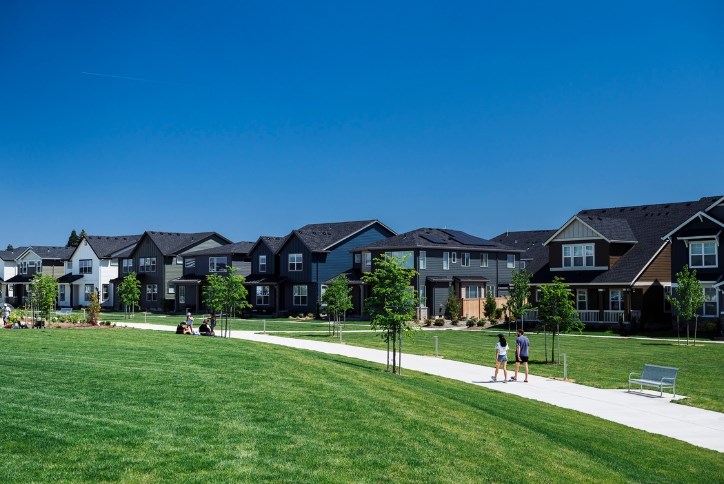
06 February . 2025
Is Hillsboro, Oregon Portland’s most affordable suburb?
Located about 16 miles from Portland, Oregon, the suburb of Hillsboro offers a refreshing contrast to its big-city neighbor, bringing together small-town charm and a thriving tech scene. Sure, Portland grabs the headlines—both good and bad—but Hillsboro has been quietly shining for years, named a Best Place to Live multiple times thanks to a high priority on sustainability, a resilient economy with large employers, and a diverse and welcoming feel.
From cost of living to a true sense of community, this blog will explore the benefits of life in a small city like Hillsboro. But we think one Redditor summed it up nicely: “It’s cute, affordable, on the light rail, and close to the coast.” What’s not to love?!?

Housing costs in Portland vs. Hillsboro
Here's a shocking statistic: Realtor.com predicts that within the next 10 years, the median home price in Portland could exceed $1 million. In the past five years, home prices in the area have risen a whopping 45 percent. But don’t let that fool you—homes are still moving, and fast. It's a typical seller's market, where the number of buyers outweighs the available homes, making competition fierce.
While Hillsboro might be more bite-sized, it packs a punch. Current data from BestPlaces.net shows the city's housing costs are about 14 percent less expensive than Portland, and the median sold price is lower than the list price. This signals a more balanced market where supply meets demand—which can mean a more relaxed buying experience for you. Plus, the price per square foot is lower than in PDX, meaning you get more bang for your buck.
In new neighborhoods like Reed’s Crossing, Hillsboro’s housing market boasts more homes focused on energy-efficiency and sustainability. From better insulation and state-of-the-art HVAC systems to energy-saving appliances, new homes are designed to help keep monthly costs low and comfort levels high; studies have shown that a new construction home can potentially save homeowners up to 30 percent on utility bills. And contrary to popular belief, the suburbs aren't all sprawling estates—many people, like first-time homebuyers and empty nesters, are drawn to more manageable small-footprint homes. In terms of financial savings, these homes often see lower utility bills, reduced maintenance costs, and potential for higher resale value when compared to older homes.

Transportation and connectivity
Of course, there’s more to a home than its price—the second biggest cost of living expenditure for most people involves how you get around. A major benefit to living in Hillsboro is its proximity and connection to Portland’s public transit system, especially when you want an affordable way to get to the city (or the airport) without having to worry about traffic and parking.
For those who rely on cars, owning one in Portland can really add up. While the average commute time is about 25 minutes, traffic congestion can turn what should be a simple trip into an exasperating trek, and parking in many neighborhoods adds a whole other level of frustration. It’s no wonder Portland ranks as the seventh worst city for traffic in the country.
On the flip side, commuting in Hillsboro can be much easier. From Reed’s Crossing, you’re less than five miles from both Intel and Nike, two of the area’s largest employers. That means less time stuck in traffic and more time to spend with family, catch up with friends and neighbors, or enjoy some me time. Plus, South Hillsboro has been celebrated by the cycling community at BikePortland.org for its bike-friendly design and “lovely, beautiful, separated cycle tracks.” Living closer to work isn’t just convenient—it can save you time, money, and a whole lot of stress.

Economic and career opportunities
Hillsboro lies at the heart of the Silicon Forest, a cluster of high-tech companies in Washington County. At the center of it all is Intel, a global leader in semiconductor manufacturing, with multiple sprawling campuses and thousands of employees. But they’re not alone. Big names like Genentech, Thermo Fisher Scientific, and Lattice Semiconductor have all planted roots here, making Hillsboro a serious contender in the technology space.
But it’s not just about tech jobs. The tech bubble has a domino effect, energizing other sectors like healthcare, real estate, education, and local services. Experts believe that the city’s rapid job growth will continue, with current economic forecasts estimating that up to 46,459 jobs will be added by 2035. And the influx of professionals to the area has sparked a lively and diverse community, especially in newer neighborhoods like Reed’s Crossing.

Quality of life
Life in Hillsboro has a unique appeal that feels like a breath of fresh air for anyone looking to strike a balance between city life and suburban tranquility. Here in South Hillsboro, you’ll find myriad parks and outdoor spaces to explore as well as miles of multimodal paths perfect for a quick jog or a leisurely stroll. If you love to shop local, the vibrant Hillsboro Farmers’ Market at Reed’s Crossing Park will be your new favorite spot—there’s nothing quite like a market right in your neighborhood. And Reed’s Crossing Town Center will offer dining and shopping options for any day of the week, so you don’t have to venture far to pick up your everyday essentials (or a little treat).
Then, when the weekend wanderlust hits, Hillsboro's prime central location has you covered whether you're in the mood for a scenic drive through Oregon's wine country, a short trip to the coast, a jaunt along the Oregon Film Trail, or you want to explore the quirkier side of our fair state. If you’re looking for a home where convenient amenities, a close-knit community, and a high quality of life come together, Hillsboro just might be the perfect spot.
Still have questions about what living in Hillsboro is like? Take a virtual tour, come by for a visit, or sneak a peek at what’s in store for the future.

